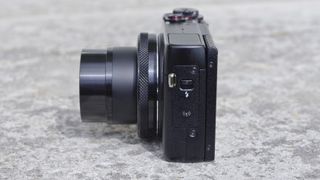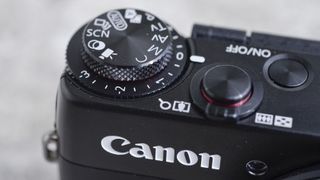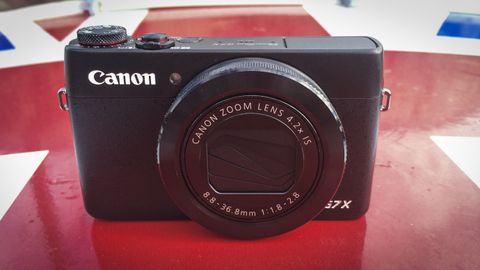Why you can trust TechRadar
Although it's a G-series camera the G7 X looks more like the S120 than the G16 or G1 X Mark II – it's much sleeker in appearance than other G-series models. At 103x60.4x40.4mm and 304g it's also just a little bigger and heavier than the S120 (100.2x59x29mm and 217g).
The new camera looks and feels like a high quality model, and there are subtle new design flourishes in the form of a flash of red at the base of the shutter release button and a mode dial on the top-plate.

Unlike the S120, the G7 X's mode dial sits above an exposure compensation dial with settings running in the range +/-3EV. Both are within easy reach of the thumb and forefinger and it means exposure can be adjusted very quickly.
There's also a control ring around the lens and in the default set-up this is used to set aperture, but it can be quickly changed to adjust sensitivity, manual focus, white balance, focal length, dynamic range, shadow correction and aspect ratio, along with an option selected by the photographer. In the default set-up this is done by pressing the Ring Function (Func.) button and then selecting the option that you want to adjust. The options can be scrolled using the lens ring, the navigation buttons, the scroll wheel around the navigation buttons or by touching the screen. Once the option has been selected, rotating the lens ring adjusts the selected setting. It's a very quick and easy way of working.
Canon has given the lens ring just the right level of friction. It doesn't get knocked easily out of place and it has nice positive action. It also clicks as it is rotates to indicate a change has been made, which is useful.

The control layout on the back of the G7 X is the same as the S120's, and the navigation controls are also shortcut buttons to access the flash and macro shooting options. As mentioned earlier, a high quality scroll wheel surrounds these buttons to speed up menu navigation and setting selection, but selections can also be made with a touch on the screen.
The G7 X feels great in the hand, is small and neat enough to fit in a jacket pocket and has a great control arrangement, so it's easy to adjust settings quickly. The only real disappointment is the lack of a viewfinder.
The three-inch 1,040,000-dot LCD provides a detailed view, but as with most other screens it suffers from reflections in bright light and this can make composition tricky. I also found the level display hard to see on some occasions as the lines are quite fine and in some lights its difficult to see it change from red to green to indicate that the camera is level. Similarly, the Peaking display in manual exposure mode is hard to see on the screen in bright light.
I'd also prefer the screen to be a vari-angle model as this is more helpful than the tilting type when shooting upright format images from awkward angles. Nevertheless, the tilting bracket seems fairly robust and by default the image flips when the screen is tipped up through 180 degrees for selfie shooting.
On the plus-side, the screen responds promptly to touch and, although fingerprints build-up over time, it seems reasonably resistant to them.

It's also easy to connect the camera's Wi-Fi system to a device even without using the NFC (Near Field Communication) technology. Once this is done Canon's CameraWindow app can be used to view and transfer images, control the camera remotely while viewing the image on the 'phone screen and add location data. The level of control provided for remote control is limited to adjusting focal length (zoom), setting the self-timer and tripping the shutter, but it makes it easier to take selfies from further away than arm's length.
Canon has kept the menu of the G7 X fairly simple and it doesn't usually take long to find the option that you want. There's a short customisable Function menu which is accessed by pressing the Func/Set button at the centre of the navigation controls and this speeds up making some settings changes. However, it's a shame that the My Colors options aren't available when shooting raw files at the same time as JPEGs and it would be nice to be able to combine the fun Creative Shot and HDR modes with the advanced exposure modes and raw file recording.

Current page: Build and handling
Prev Page Introduction and features Next Page Image quality and resolution
